The Nexus 7 (2013) Review
by Anand Lal Shimpi on August 22, 2013 6:00 PM ESTPlatform Power & Battery Life
The new Nexus 7 moves to a slightly smaller battery compared to its predecessor (15Wh vs. 16Wh). The result however is anything but a reduction in battery life. ASUS and Google worked hard to reduce platform power consumption as much as possible. I instrumented both Nexus 7s and measured total platform power, excluding display, to look at the impact of the silicon platform (SoC, PMIC, DRAM, eMMC, WiFi, etc...). The results are beyond impressive:
Idle power is cut in half compared to last year's model. This is by far the most important improvement as most mobile usage models tend to have long periods of idle time. We'll see these power gains reflected in our web browsing test which does have significant periods of simulated reading time between web page loads. The power reduction while running Kraken grows to just over 20%, and even while running Geekbench 3 we see a 16% drop with the new Nexus 7. Only our offscreen 3D test manages to draw more power on the new Nexus 7 than the old one, and that isn't taking into account the nearly 5x increase in performance on the new Nexus. In fact, as impressive as these numbers are - they are even more impressive when you take into account performance. To make a long story short, don't worry about the ~7% decrease in battery capacity as there are enough improvements in platform power and performance (and thus perf per watt) to more than make up for the smaller battery.
We'll start out with our WiFi web browsing test. Like all of our battery life benchmarks we run this test with all devices calibrated to 200 nits and connected to 5GHz 802.11 WiFi (if supported). The test itself cycles through a bunch of desktop websites at a very aggressive frequency. Our test ensures that both the CPU cores and wireless stack can reach their deep sleep states during simulated reading periods. The test continues until the battery is depleted.
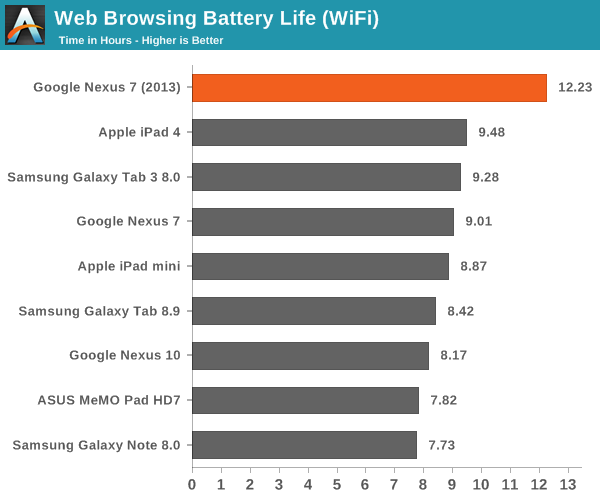
The new Nexus 7 does better here than any other small tablet we've ever tested. Remember that 50% decrease in idle platform power? That's exactly why we're seeing a 35% improvement in battery life compared to the original Nexus 7.
Our video playback test involves looping the playback of a 4Mbps 720p High Profile H.264 transcode of the last Harry Potter Blu-ray. All displays are calibrated to 200 nits.
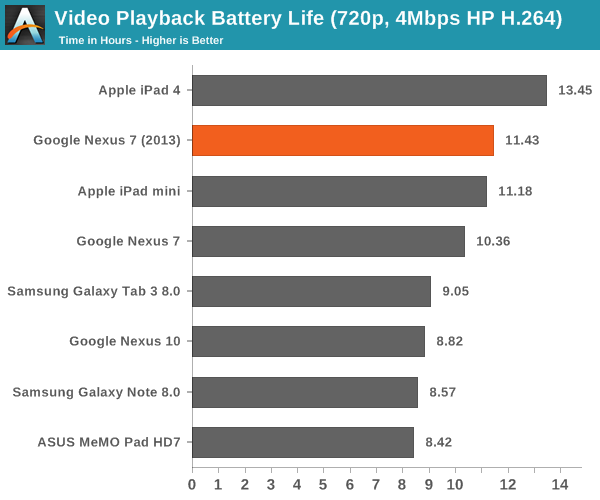
Video decode blocks are fairly well optimized to begin with, so there's not a ton of room for improvement here compared to last year's Nexus 7. Despite the ~7% shrink in battery capacity, the new model manages a 10% increase in battery life though. We also have the first small Android tablet capable of beating the iPad mini in a video playback test here - job well done ASUS/Google.
Our final test involves looping the Egypt HD benchmark until the battery is completely drained. Frame rates are capped to 30 fps to somewhat simulate actual gameplay and not penalize faster GPUs.
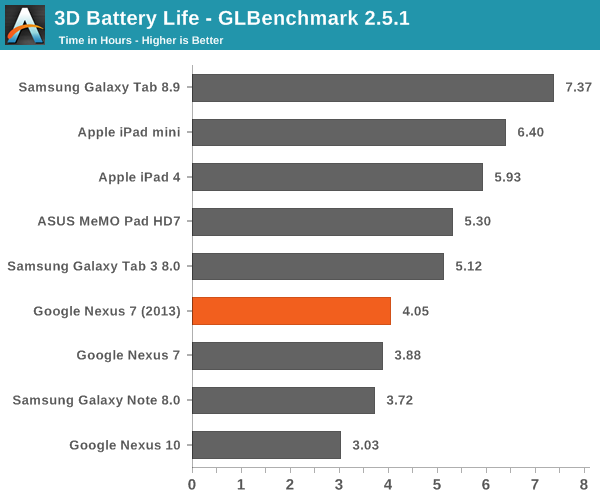
The new Nexus 7 manages to deliver slightly better battery life here despite driving higher frame rates and more pixels. Overall performance here isn't anything super impressive, the only average showing from the Nexus 7.
Google ships the Nexus 7 with an ASUS branded 7W charger, identical to the one you'd find in the box of a MeMO Pad HD7. Given identical chargers and battery capacities, there's no surprise the new Nexus 7 takes the same amount of time to charge as the MeMO Pad HD7 (~3.5 hours).
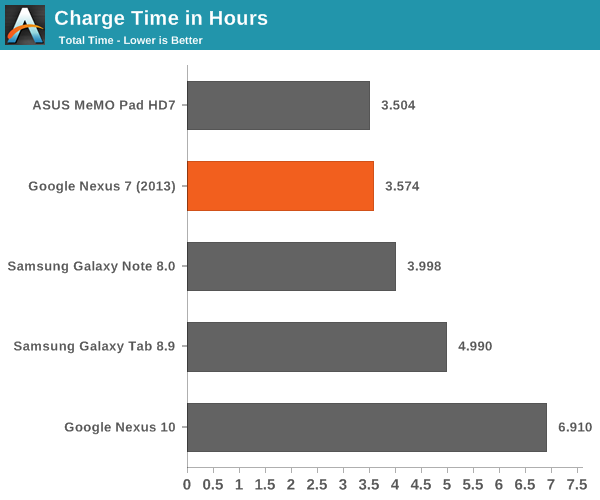
The new Nexus 7 also supports wireless charging by implementing the Qi standard. Charge time is a bit slower wirelessly as Qi can only charge at up to 5W. Brian tested Qi functionality in his mini review of the Nexus 7 and didn't have any issues.


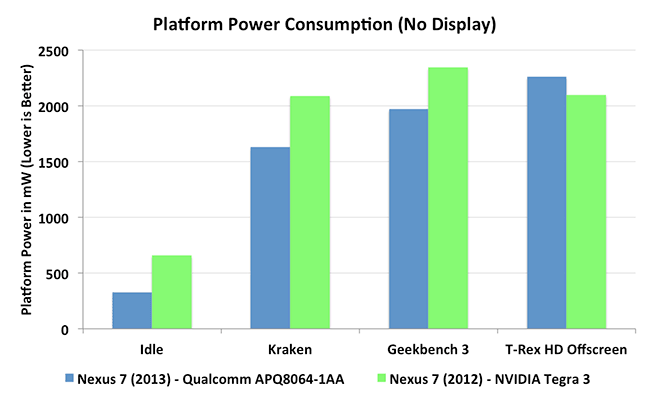









202 Comments
View All Comments
darwinosx - Thursday, August 22, 2013 - link
I'll review it. It's a piece of junk with poor quality build, a washed out screen, and a really slow gpu. The iPad 4 blows the doors off it. Hows that?smartypnt4 - Thursday, August 22, 2013 - link
You're an incredibly negative individual, do you know that? Everyone knows the iPad 4 is better than the N10. That's never really been a debate. The N10 also costs $100 less, so there's that.I agree with your essential assessment, though. In essence, it had build quality issues, and a dreadful screen in comparison to the N7 and the iPad 3/4. Colors were washed out, it was incredibly dim, lacked contrast, etc. The really slow GPU thing I can't really attest to, although benchmarks indicate it's not *horribly* slow, especially for something that came out last year. Yes, it's slower than the iPad 4. Basically, anything released within ~6 months of an iPad historically can't match the GPU power. Comparing it to the Android space, it was relatively quick last year. Not so much now, though.
I do agree with you, though. Proof: when my N10 was stolen, I replaced it with an iPad 4.
Midwayman - Friday, August 23, 2013 - link
Anything from 2012 with a full HD screen or higher running Android was underspec'd anyways. They hadn't upped the hardware to deal with the demands of the higher res screens yet. 2013 is looking to be a different matter.smartypnt4 - Sunday, August 25, 2013 - link
After owning and using the N10 at launch last year, I can say that I never felt that the GPU held it back in the OS. The transitions were all very smooth throughout the OS. Some apps behaved weirdly, but that was because they rendered to a fixed size, which looks comical on a tablet with a pixel density that high. There were plenty of other things that were off about the N10, though. Supposedly ASUS got the nod for this year's Nexus 10, so I'm looking forward to their take on it.jl0329 - Wednesday, October 9, 2013 - link
Go home, time to change your diaper you little brat.Krysto - Thursday, August 22, 2013 - link
I agree they should move to 8" next year, or at least 7.7", and no more than a width of five inches, because then it becomes too wide (the iPad Mini is too wide for one-hand use).But yeah I'd prefer it was a bit bigger to justify getting one when you already have a big smartphone.
sherlockwing - Thursday, August 22, 2013 - link
Don't know about you, but I bought a N7 2013 when I already have a GS4(5") and the Media viewing expewrience on the Nexus 7 is substantially better. The N7's display(22.02 in^2) is twice as large as GS4's(10.68 in^2), and 85% more space when viewing 16:9 content( 19.8 vs 10.68). I find it perfectly justifiable to buy even if I have a GS4.Now if your defination for "big smartphone" is a Note then I see your point. It won't take too much effort to get a 7.5" screen on N7 if the bezel is reduced to Ipad Mini level. The screen/front area ratio of N7 is only 62%, Ipad mini's is 71.8%.
CSMR - Thursday, August 22, 2013 - link
"802.11ac is probably the only thing missing from this otherwise awesome platform"802.11ac will take years to start being used, and decades before it makes earlier wifi standards obsolete. In the life of a current device, there will be no occasions when 802.11ac will be available and providing internet but other wifi standards are not.
Lack of cellular connectivity on the other hand results in lack of internet access in most locations, and is a major omission.
solipsism - Thursday, August 22, 2013 - link
If you're defining it as not being used anywhere by anyone in favour of a new standard, then I guess I agree it will take decades. But by that notion there are people still using floppy disks.If you wish to be less draconian with your definition then your decades claim doesn't hold water. Including 802.11b in a device that supports 802.11g/n as a back up that is inexpensive for the component vendor to include doesn't mean it's being utilized extensively.
Also note is was only a decade between the 802.11b and n standards and 802.11n took off faster (for various reasons) than 802.11b so I can't see how it will be at least 2x longer before it gains a foothold, especially considering the focus society has for WiFi and excellent job the committee did in ratifying ac compared to n.
Finally, "there will be no occasions when 802.11ac will be available" and "802.11ac will take years to start being used" are just outright wrong. I use 802.11ac every single day. It's available! You can buy routers and devices that use this standard and they aren't priced at levels that make it unreasonable to obtain.
CSMR - Friday, August 23, 2013 - link
I was not saying it will take decades for people to start using 802.11ac. What will take decades is for them to switch off 802.11g and 802.11n. You may use 802.11ac now and good for you, but you can still get an internet connection with 802.11g/n. The main advertised advantage of 802.11ac is speed, but it will at least 10 years until typical internet connections saturate an 802.11g link let alone 802.11n.I am not against putting 802.11ac in devices as soon as it becomes a standard integrated part of modern chipsets, but the point is always-on internet is important, and if you do not have cellular connectivity then you will lack internet whenever you are outside your wifi network.